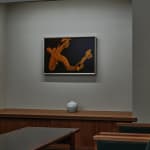Morita Shiryū (1912–1998)
Ki
Aluminum flake pigment and lacquer on paper, framed
c. 1964
With a label signed by Inada Sousai
52 x 79 cm
56 x 83 cm (overall)
c. 1964
With a label signed by Inada Sousai
52 x 79 cm
56 x 83 cm (overall)
Literature
Morita Shiryu Catalogue Raisonné: 1952–1998. Uji: Soryusha, 2019.
The character ki has sixteen strokes in standard script but Morita renders it here using only four in a highly expressive cursive form. The first and second strokes are short downward strokes, followed by a change in direction upwards, then reversing again in a downward meandering line from the upper center heading first down, and then continuing to the right in a single fluent motion. The movement concludes near the right margin with another abrupt turn to the lower center, eventually stopping in a single dot. For the first and second strokes, the brush is soaked with pigment, creating a dense and saturated impression. Further lines seem to float on the surface, an effect achieved with smooth variations of direction and width of the strokes, and the brush’s hairs drying out quickly and starting to separate. Compared to Usobuku (pp. 36-37) which uses the same technique of shikkin, the present work appears more fluent and self-assured.
Ki literally means “tree.” In Morita’s own explanation, the character carries another layer of meaning, suggesting the long history or fundamentals of calligraphy as represented by the shape of the tree trunk, a symbol of the efforts of calligraphers past and present. It also embodies the idea that the life of a calligrapher is no more than a single branch of a tree. Every step taken and every effort made by calligraphers are as insignificant as is life, but within this impermanence exists eternity.
Morita Shiryu (avant-garde calligrapher; 1912–1998)
Avant-garde calligrapher from Hyogo Prefecture. Like fellow artist Inoue Yuichi, Morita studied under the calligraphy master Ueda Sokyu. He co-founded the avant-garde group Bokujinkai together with Inoue and was the founder and editor of the journal Bokubi (Beauty of Ink), both of which revolutionized traditional Japanese calligraphy and spread knowledge of Japanese avant-garde calligraphy to an international audience. He was posthumously awarded the Medal of Honor with Dark Blue Ribbon.
Ki literally means “tree.” In Morita’s own explanation, the character carries another layer of meaning, suggesting the long history or fundamentals of calligraphy as represented by the shape of the tree trunk, a symbol of the efforts of calligraphers past and present. It also embodies the idea that the life of a calligrapher is no more than a single branch of a tree. Every step taken and every effort made by calligraphers are as insignificant as is life, but within this impermanence exists eternity.
Morita Shiryu (avant-garde calligrapher; 1912–1998)
Avant-garde calligrapher from Hyogo Prefecture. Like fellow artist Inoue Yuichi, Morita studied under the calligraphy master Ueda Sokyu. He co-founded the avant-garde group Bokujinkai together with Inoue and was the founder and editor of the journal Bokubi (Beauty of Ink), both of which revolutionized traditional Japanese calligraphy and spread knowledge of Japanese avant-garde calligraphy to an international audience. He was posthumously awarded the Medal of Honor with Dark Blue Ribbon.



